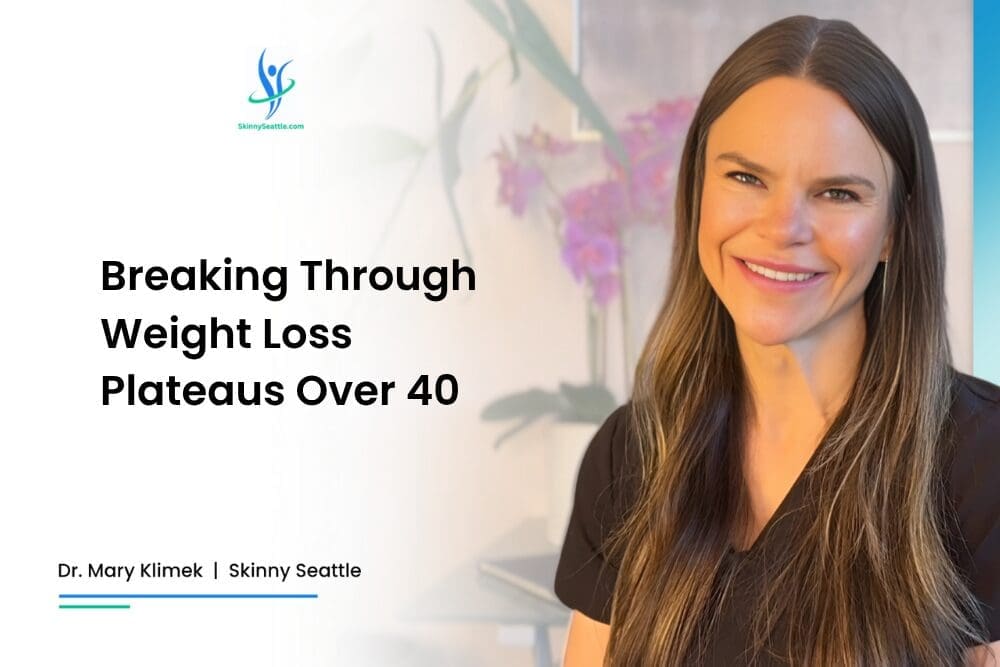
You are eating healthy, exercising, and doing all the “right” things. Yet the scale has not budged for weeks or even months. If this sounds familiar, you are not alone. Many women over 40 hit weight loss plateaus because their bodies adapt differently to diet and exercise than they did in their 20s and 30s.
At Skinny Seattle, we help midlife women understand the science behind weight plateaus and create strategies to move past them. This blog explores why plateaus happen, what your metabolism is really doing, and how lab testing and personalized solutions can help you break through.
Why Weight Loss Plateaus Happen More Often After 40
Weight loss plateaus occur when your body adapts to calorie restriction and exercise. This is part of a survival mechanism called adaptive thermogenesis, where your body tries to conserve energy by slowing down metabolism.
In younger years, metabolism is more flexible and rebounds quickly. After 40, hormonal changes make it harder to push past plateaus. Declines in estrogen, progesterone, and thyroid hormones can all reduce metabolic efficiency. Add stress and insulin resistance into the mix, and your body holds on to weight no matter how disciplined you are.
Understanding Metabolic Flexibility
Metabolic flexibility is your body’s ability to switch between burning carbohydrates and burning fat. When you are metabolically flexible, you can handle occasional changes in diet or exercise without stalling progress.
Women who are stuck in a plateau often have lost metabolic flexibility. This can look like:
- Intense cravings for sugar or carbs
- Fatigue if you go too long without eating
- Poor workout recovery
- Difficulty losing fat even with calorie restriction
Regaining metabolic flexibility is key to moving past a plateau.
Adaptive Thermogenesis: The Plateau Mechanism
Adaptive thermogenesis is your body’s way of adjusting to weight loss efforts. It lowers your resting metabolic rate to “save” calories when it perceives a threat, such as reduced food intake. This was helpful for survival in ancient times but is frustrating when you are trying to shed pounds in midlife.
Signs you may be experiencing adaptive thermogenesis include:
- A sudden weight loss stall despite consistent habits
- Feeling colder than usual
- Increased fatigue or sluggishness
- Stronger hunger cues
Breaking through requires strategic adjustments, not more restriction.
How Lab Testing Reveals Hidden Roadblocks
One of the most powerful tools for understanding weight plateaus is lab testing. At Skinny Seattle, we use testing to uncover hidden imbalances that make plateaus harder to overcome. These include:
- Thyroid testing: To evaluate if low thyroid hormones are slowing metabolism.
- Insulin and glucose testing: To check for insulin resistance.
- Cortisol mapping: To understand stress hormone patterns that drive belly fat.
you are left guessing. With testing, you can target the exact issue and create an effective plan.
Learn more about our lab-guided approach.
Solutions for Breaking Weight Loss Plateaus
If you are stuck, the solution is not more willpower. It is smarter strategies that work with your midlife metabolism. Here are key approaches we use with clients:
1. Reset Your Metabolism
A metabolic reset uses food timing, macronutrient balance, and stress reduction to “teach” your body to burn fat again. This often includes:
- Alternating between higher-carb and lower-carb days
- Including adequate protein at each meal
- Prioritizing rest and recovery
Explore our personalized metabolic reset programs for midlife women.
2. Stress Management
Chronic stress raises cortisol, which makes plateaus worse. Daily stress management helps reduce cortisol and supports fat loss.
- Deep breathing or short meditations
- Walking in nature
- Limiting caffeine and alcohol
3. Meal Timing Adjustments
When and how you eat matters. For many women, eating balanced meals earlier in the day improves blood sugar and reduces evening cravings.
- Eat within an hour of waking
- Avoid skipping meals, which can spike cortisol
- Finish dinner 2 to 3 hours before bedtime
4. Address Nutrient Gaps
Nutrient deficiencies can contribute to plateaus. Supplements may help, depending on individual lab results.
- Magnesium for insulin sensitivity
- Vitamin D for metabolism and energy
- Adaptogens like ashwagandha for cortisol balance
Read more about our supplement protocols.

Why Bellevue Women Trust Skinny Seattle
Women across Bellevue, Redmond, Sammamish, and Kirkland choose Skinny Seattle for a reason. We understand the complexity of midlife weight loss and provide personalized, compassionate care.
Our clients appreciate that we:
- Use lab testing to remove the guesswork
- Provide one-on-one coaching
- Create practical strategies that fit real life
This is not about extreme diets. It is about creating a program that works with your body.
Book a Metabolic Reset Session
If you are stuck in a plateau, do not keep spinning your wheels. A metabolic reset session helps you understand what is blocking your progress and gives you a personalized plan to move forward.
Book your metabolic reset session today and take the first step toward results that last.
Frequently Asked Questions
Why do weight loss plateaus happen more often after 40?
Hormonal shifts reduce metabolic flexibility and make your body more prone to adaptive thermogenesis. This slows down metabolism and makes weight loss harder without adjustments.
Can lab testing really help break a plateau?
Yes. Lab testing reveals hidden imbalances such as thyroid issues, insulin resistance, or cortisol spikes that are not obvious without data.
What is the best way to break through a plateau?
The best approach is a metabolic reset that restores flexibility, balances hormones, and adjusts nutrition and stress management for your unique needs.
